Things that Make You Go *BOOM* (Part the Second)
The hubby and I are currently waiting on two guns from master gunsmith, Dale Shinn. For those who aren’t familiar with Dale: This is a man who makes everything on his guns, down to the springs. He does not make his own barrels, because he has them professionally cast for safety reasons. Dale’s guns look like they were just picked up out of a museum case - and some of his pieces are actually *in* museum cases.
*doing a little dance of glee at the thought of owning one*
Needless to say, there is a waiting list (I actually got on that list before my husband and I got together), but we are slowly approaching our project completion date at last! With any luck, Dale won't get in any more car accidents between now and then! *knocks on wood*
The pieces we are getting are as follows:
1) 2 sets of brass cartridges (10 each)
2) 2 “ doughnut” German powder flasks (each with it's own set of decorations)
3) 1 brass-barreled octagonal-to-round button lock
4) 1 steel-barreled matchlock with 'brass knuckles' sear guard
The cartridges are one-of-a-kind pieces, based on both safety and Dale’s knowledge of the period. They are *not* the standard ECW wooden cartridges (also called apostles by some). We don’t do ECW, we do 16th C; early 16th C.
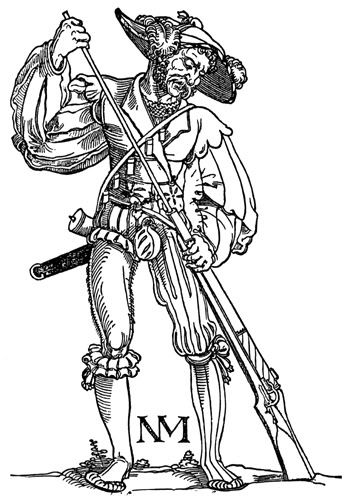
A lot of folks doing early period still get the ECW cartridges because a) there is nothing out there on the market that is closer to period, b) the ECW cartridges work and have been field tested extensively, c) they are safe, d) they are easy to keep track of and e) they are conveniently tied together to keep them from loosing pieces.
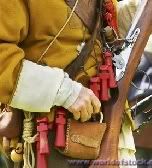
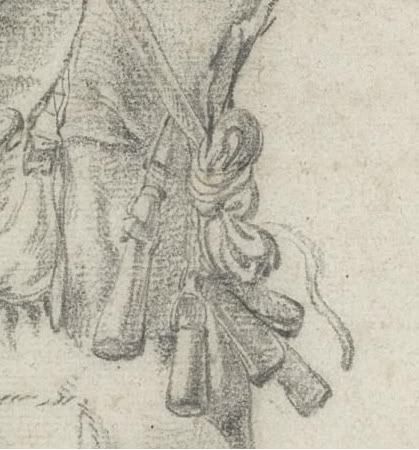
Now to be honest, the cartridges we are getting are a ‘hybrid’ rather than a “straight out of the woodcut” reproduction of German black-powder storage vessels.

The caps will not be attached *directly* to the bandoleer in the manner that the 16th C versions seem to - for both safety considerations, and because the later period ‘stringers’ help you to keep track of empty vs. full cartridges and prevent loss of caps/bases. They also have a bit of a 'flare' to their bases. I am not honestly sure where Dale got this from, but I like it and I trust his research (he's been doing guns for about 40 years after all...).
Right now, the cartridges are the only piece of the order we have in hand. We are hoping to see the leather smiths who will be helping us out with the bandoleer/patch pouch production this weekend.
That being the case, I want to organize some thoughts on these leather bits of our kit.
Namely, hubby is insistent that we have to have patch pouches, and I can’t find evidence of them in any images of gunners from the 16th C.!
Here is what I have found that *may* be a patch pouch…
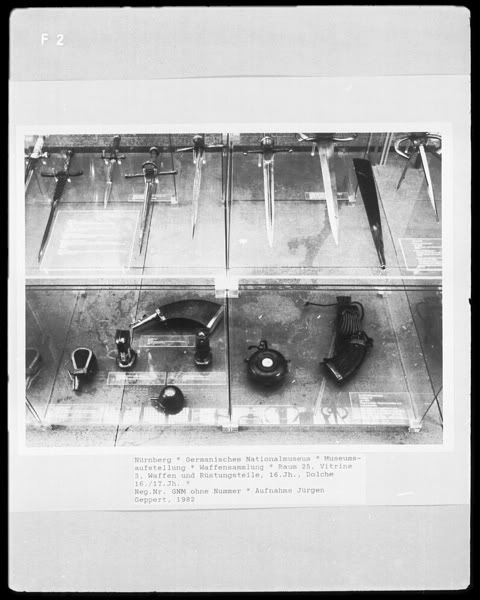
Lower right hand corner, under the powder horn; I can’t tell what it is attached to, or how the horn is attached to it. But that is the *first* pouch I have seen in relation to any black-powder item from the period.
So, my current plan is to get a thin leather bandoleer strap made, with a small pouch like this one at the joint in the strap/over my hip. My ‘doughnut’ powder flask can be tied to the same point, and I’ll end up with something similar to the arrangement in the Bildindex image.
Then again, if anyone has any *other* images of leather black-powder gear from this period that they would like to share that may change my mind…feel free!
On another note, hubby had indicated that at least a couple of the cartridges from the 10 cartridge sets should be hung on the 'back side' of the bandoleer. However, I am not sure I have seen this in 16th C German images. I know that there was a detail shot of a large color painting that showed the back of some
Harquebusiers...anyone know where that is?
From the ECW era:
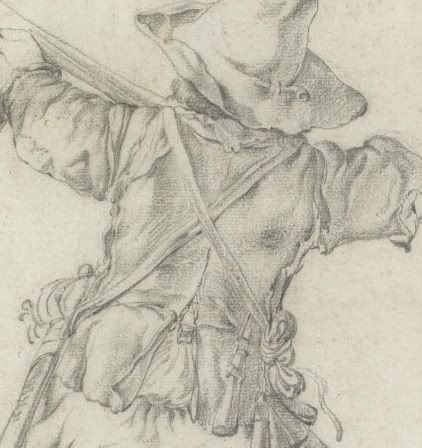
Of course, the casual shooting scenes I have don't show ANY kit except the guns...*le sigh*
